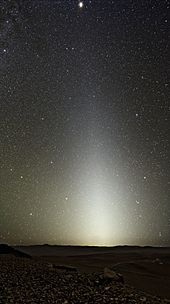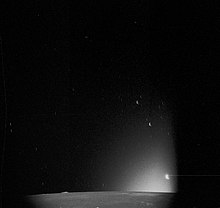Zodiacal light
Parts of this article (those related to the hypothesized origin of the zodiacal cloud - Mars dust, rather than comets or asteroids) need to beupdated.(March 2021) |

Zodiacal lightis a faint glow ofdiffuselight in the skyscatteredbyinterplanetary dust,particularly a zodiacal cloud, along theecliptic,and therefore thezodiac.It is mostly only visible in very dark conditions across thenight skyalong the wholeeclipticas thezodiacal band,[2]backscatteredslightly brighter from an oval area of the banddirectly oppositeto the light source as thegegenschein(orcounterglow) and brightest as a triangle-shaped area at the horizon around the light source asfalse dawn,mostly just before or after theSunrises or sets.[3][4][5][6]
Zodiacal light contributes[7]to the natural light of the sky, though since zodiacal light is very faint, it is often outshined and rendered invisible bymoonlightorlight pollution.
The interplanetary dust in theSolar Systemforms a thick, pancake-shaped cloud called the zodiacal cloud which straddles the ecliptic plane. Theparticle sizesrange from 10 to 300micrometres,implying masses from onenanogramto tens ofmicrograms.[8][9]
ThePioneer 10andHeliosspacecraft observations in the 1970s revealed zodiacal light to be scattered by theinterplanetary dust cloudin the Solar System.[10][11] Analysis of images of impact debris from theJunospacecraft shows that the distribution of the dust extends from Earth's orbit to the 4:1orbital resonancewith Jupiter at2.06 AU,and suggests that the dust is from Mars.[12]However, no other dedicated dust instrumentation onPioneer 10,Pioneer 11,Galileo,Ulysses,andCassinifound an indication that Mars is a significant source of dust besides comets and asteroids.[10][13][14][15]
Viewing[edit]

In the mid-latitudes, the zodiacal light is best observed in the western sky in the spring after the evening twilight has completely disappeared, or in the eastern sky in the autumn just before the morning twilight appears. The zodiacal light appears as a column, brighter at the horizon and tilted at the angle of the ecliptic. The light scattered from extremely small dust particles is stronglyforward scattering,although the zodiacal light actually extends all the way around the sky, hence it is brightest when observing at a small angle with the Sun. This is why it is most clearly visible near sunrise or sunset when the Sun is blocked, but the dust particles nearest the line of sight to the Sun are not. The dust band that causes the zodiacal light is uniform across the whole ecliptic.
The dust further from the ecliptic is almost undetectable except when viewed at a small angle with the Sun. Thus it is possible to see more of the width at small angles toward the Sun, and it appears wider near the horizon, closer to the Sun under the horizon.
Origin[edit]

The source of the dust has been long debated. Until recently, it was thought that the dust originated from the tails of activecometsand from collisions betweenasteroidsin theasteroid belt.[17]Many of our meteor showers have no known active comet parent bodies. Over 85 percent of the dust is attributed to occasional fragmentations of Jupiter-family comets that are nearlydormant.[18]Jupiter-family comets have orbital periods of less than 20 years[19]and are considered dormant when not actively outgassing, but may do so in the future.[20]The first fully dynamical model of the zodiacal cloud demonstrated that only if the dust was released in orbits that approach Jupiter, is it stirred up enough to explain the thickness of the zodiacal dust cloud. The dust in meteoroid streams is much larger, 300 to 10,000micrometresin diameter, and falls apart into smaller zodiacal dust grains over time.

ThePoynting–Robertson effectforces the dust into more circular (but still elongated) orbits, while spiralling slowly into the Sun. Hence a continuous source of new particles is needed to maintain the zodiacal cloud.Cometarydust and dust generated by collisions among theasteroidsare believed to be mostly responsible for the maintenance of the dust cloud producing the zodiacal light and thegegenschein.
Particles can be reduced in size by collisions or by space weathering. When ground down to sizes less than 10 micrometres, the grains are removed from the inner Solar System by solar radiation pressure. The dust is then replenished by the infall from comets. Zodiacal dust around nearby stars is calledexozodiacal dust;it is a potentially important source of noise in attempts to directly imageextrasolar planets.It has been pointed out that this exozodiacal dust, or hot debris disks, can be an indicator of planets, as planets tend to scatter the comets to the inner Solar System.
In 2015, new results from the secondary ion dust spectrometer COSIMA on board theESA/Rosettaorbiter confirmed that the parent bodies of interplanetary dust are most probably Jupiter-family comets such as comet67P/Churyumov–Gerasimenko.[22]Data from theJunomission indicate that the dust close to Earth has a local origin in the inner Solar System, best fitting the planet Mars as a source.[23]
Appearance[edit]


Zodiacal light is produced by sunlight reflecting off dust particles in the Solar System known ascosmic dust.Consequently, itsspectrumis the same as thesolarspectrum. The material producing the zodiacal light is located in a lens-shaped volume of space centered on the sun and extending well out beyond theorbitof Earth. This material is known as theinterplanetary dust cloud.Since most of the material is located near the plane of the Solar System, the zodiacal light is seen along theecliptic.The amount of material needed to produce the observed zodiacal light is quite small. If it were in the form of 1 mm particles, each with the samealbedo(reflecting power) as theMoon,each particle would be 8 km from its neighbors. Thegegenscheinmay be caused by particles directly opposite the Sun as seen from Earth, which would be in fullphase.
According to Nesvorný and Jenniskens, when the dust grains are as small as about 150 micrometres in size, they will hit the Earth at an average speed of 14.5 km/s, many as slowly as 12 km/s. If so, they pointed out, thiscomet dustcan survive entry in partially molten form, accounting for the unusual attributes of themicrometeoritescollected in Antarctica, which do not resemble the largermeteoritesknown to originate fromasteroids.In recent years, observations by a variety of spacecraft have shown significant structure in the zodiacal light including dust bands associated with debris from particularasteroid familiesand several cometary trails.
Cultural significance[edit]
According toAlexander von Humboldt'sKosmos,Mesoamericans were aware of the zodiacal light before 1500.[24]It was perhaps first reported in print byJoshua Childreyin 1661. The phenomenon was investigated by the astronomerGiovanni Domenico Cassiniin 1683. According to some sources, he explained it by dust particles around the Sun.[25][26]Other sources state that it was first explained this way byNicolas Fatio de Duillier,in 1684,[27]whom Cassini advised to study the zodiacal light.[24]
Importance to Islam[edit]
This sectionneeds additional citations forverification.(May 2024) |
TheIslamicprophetMuhammaddescribed zodiacal light in reference to the timing of thefive daily prayers,calling it the "false dawn" (الفجر الكاذبal-fajr al-kādhib)[citation needed].Muslim oral tradition preserves numerous sayings, orhadith,in which Muhammad describes the difference between the light of false dawn, appearing in the sky long after sunset, and the light of the first band of horizontal light at sunrise, the "true dawn" (الفجر الصادقal-fajr al-sādiq).[28][29]According to the vast majority of Muslim scholars,astronomical dawnis considered the true dawn. Practitioners of Islam use Muhammad's descriptions of zodiacal light to avoid errors in determining the timing of daily prayers.[citation needed]
Brian May[edit]
In 2007,Brian May,lead guitarist with the bandQueen,completed histhesis,A Survey of Radial Velocities in the Zodiacal Dust Cloud,thirty-six years after abandoning it to pursue a career in music.[30]He was able to submit it only because of the minimal amount of research on the topic undertaken during the intervening years. May described the subject as being one that became "trendy" again in the 2000s.[31]
Other planets[edit]

Other planets, like Venus or Mercury,[32]have shown to have rings of interplanetary dust in their orbital spaces.
See also[edit]
References[edit]
- ^"False Dawn".eso.org.Retrieved14 February2017.
- ^Darling, David."Zodiacal cloud".Internet Encyclopedia of Science.
- ^"APOD: 2012 January 16 - Zodiacal Light and the False Dawn".
- ^"What are Zodiacal Lights?".
- ^"EarthSky | Zodiacal light: All you need to know".6 September 2021.
- ^Coffey, Rebecca."In Early March, Look To The West For The Zodiacal Light!".Forbes.Retrieved2021-06-05.
- ^Reach, W. T. (1997). "The structured zodiacal light: IRAS, COBE, and ISO observations".Diffuse Infrared Radiation and the Irts.124:1.Bibcode:1997ASPC..124...33R.
- ^Peucker-Ehrenbrink, Bernhard; Schmitz, Birger (2001).Accretion of extraterrestrial matter throughout earth's history.Springer. pp. 66–67.ISBN978-0-306-46689-2.
- ^McCracken, C. W. (1967). "Conditions of encounter between dust and the planets".Smithsonian Contributions to Astrophysics.11:213.Bibcode:1967SCoA...11..213M.
- ^abHanner, M. S. (1976)."Pioneer 10 observations of zodiacal light brightness near the ecliptic: Changes with heliocentric distance".Interplanetary Dust and Zodiacal Light.Lecture Notes in Physics. Vol. 48. pp. 29–35.Bibcode:1976LNP....48...29H.doi:10.1007/3-540-07615-8_448.ISBN978-3-540-07615-5.
- ^Leinert, Ch.; Röser, S.; Buitrago, L. (February 1983)."How to maintain the spatial distribution of interplanetary dust".Astronomy and Astrophysics.118(2): 345–357.Bibcode:1983A&A...118..345L.Retrieved28 July2022.
- ^Shekhtman, Lonnie (9 March 2021)."Serendipitous Juno Detections Shatter Ideas About Origin of Zodiacal Light".Jet Propulsion Laboratory.NASA.Archivedfrom the original on 18 March 2021.Retrieved19 March2021.
- ^Humes, D. (November 1980)."Results of Pioneer 10 and 11 Meteoroid Experiments: Interplanetary and Near-Saturn".Journal of Geophysical Research.85(A11): 5841–5852.Bibcode:1980JGR....85.5841H.doi:10.1029/JA085iA11p05841.Retrieved28 July2022.
- ^Grün, E.; et al. (October 1997)."South-North and Radial Traverses through the Interplanetary Dust Cloud".Icarus.129(2): 270–288.Bibcode:1997Icar..129..270G.doi:10.1006/icar.1997.5789.
- ^Soja, R.H.; Grün, E.; Strub, P.; Sommer, M.; Millinger, M.; Vaubaillon, J.; Alius, W.; Camodeca, G.; Hein, F.; Laskar, J.; Gastieau, M.; Fienga, A.; Schwarzkopf, G.H.; Herzog, J.; Gutschke, K.; Skuppin, N.; Srama, R. (August 2019)."IMEM2: a meteoroid environment model for the inner solar system".Astronomy & Astrophysics.628(A109): 13.Bibcode:2019A&A...628A.109S.doi:10.1051/0004-6361/201834892.S2CID199117335.Retrieved24 January2022.
- ^"Moonlight and Zodiacal Light Over La Silla".ESO Picture of the Week.Retrieved21 July2013.
- ^Espy, Ashley J.; Dermott, S.; Kehoe, T. J. (September 2006). "Towards a Global Model of the Zodiacal Cloud".Bulletin of the American Astronomical Society.38:557.Bibcode:2006DPS....38.4101E.
- ^Nesvorný, David; Jenniskens, Peter; Levison, Harold F.; Bottke, William F.; Vokrouhlický, David; Gounelle, Matthieu (April 20, 2010). "Cometary Origin of the Zodiacal Cloud and Carbonaceous Micrometeorites. Implications for hot debris disks".Astrophysical Journal.713(2): 816–836.arXiv:0909.4322.Bibcode:2010ApJ...713..816N.doi:10.1088/0004-637x/713/2/816.S2CID18865066.
- ^Jenniskens, Petrus Matheus Marie (2006).Meteor showers and their parent comets.Cambridge University Press.p. 108.ISBN978-0-521-85349-1.
- ^SPACE Staff (6 January 2011)."Comet or Asteroid? Big Space Rock Has Identity Crisis".SPACE.Retrieved23 May2011.
Dormant comets retain some subsurface volatiles and may start outgassing once again as they near the sun.
- ^"Romantic Sunset over the VLT".eso.org.European Southern Observatory.Retrieved21 April2015.
- ^Rita Schulz; et al. (12 February 2015). "Comet 67P/Churyumov-Gerasimenko sheds dust coat accumulated over the past four years".Nature.518(7538): 216–218.Bibcode:2015Natur.518..216S.doi:10.1038/nature14159.PMID25624103.S2CID205242328.
- ^Space Daily: Juno data shatter ideas about origin of Zodiacal Light
- ^abLey, Willy (April 1961)."The Puzzle Called Gegenschein".For Your Information.Galaxy Science Fiction.pp. 74–84.
- ^Petrus Matheus Marie Jenniskens (14 September 2006).Meteor Showers and Their Parent Comets.Cambridge University Press. p. 531.ISBN978-0-521-85349-1.
- ^Fechtig, H.; Leinert, Ch.; Berg, O. (2001)."Historical Perspectives".Interplanetary Dust.Astronomy and Astrophysics Library. Springer Link. pp. 1–55.doi:10.1007/978-3-642-56428-4_1.ISBN978-3-642-62647-0.Retrieved23 March2022.
- ^Steven J. Dick (31 August 2013).Discovery and Classification in Astronomy: Controversy and Consensus.Cambridge University Press. p. 350.ISBN978-1-107-03361-0.
- ^Sahih Muslim 1094c – The Book of Fasting – Sunnah – Sayings and Teachings of Prophet Muhammad (صلى الله عليه و سلم)
- ^"Sahih Moslim (The Authentic Hadiths of Muslim) 1-4 Vol 2: صحيح مسلم 1/4 [عربي/إنكليزي] ج2".January 2011.
- ^May, Brian (2007).A Survey of Radial Velocities in the Zodiacal Dust Cloud.Springer Nature.Bibcode:2007asor.book.....M.doi:10.1007/978-0-387-77706-1.hdl:10044/1/1333.ISBN978-0-387-77705-4.Retrieved27 May2017.
- ^Terri Gross interviews Brian May,National Public Radio showFresh Air
- ^Frazier, Sarah (2021-04-16)."NASA's Parker Solar Probe Sees Venus Orbital Dust Ring".NASA.Retrieved2023-01-21.
External links[edit]
- Reach, W. T. (1997)."The structured zodiacal light: IRAS, COBE, and ISO observations".Diffuse Infrared Radiation and the IRTS. ASP Conference Series. 124, 33–40
- "Zodiacal Light and the Gegenschein", an essay by J. E. LittletonArchived2006-02-26 at theWayback Machine
- Zodiacal Light and the False DawnSeptember 25, 2007
- Zodiacal Light Over Laguna VerdeOctober 29, 2009
- Zodiacal light as seen from above the Himalayan Hills in Uttarakhand, India

